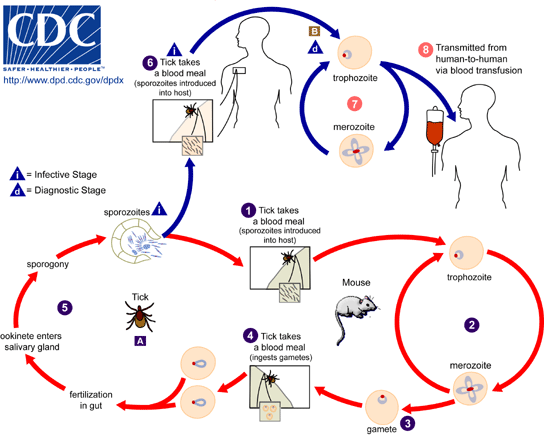Babesiosis is caused by apicomplexan parasites of the genus, Babesia. While more than 100 species have been reported, only a few have been identified as causing human infections, including B. microti, B. divergens, B. duncani, and a currently un-named strain designated MO-1.

The Babesia microti life cycle involves two hosts, which includes a rodent, primarily the white-footed mouse, Peromyscus leucopus, and a tick in the genus, Ixodes. During a blood meal, a Babesia-infected tick introduces sporozoites into the mouse host . Sporozoites enter erythrocytes and undergo asexual reproduction (budding) . In the blood, some parasites differentiate into male and female gametes although these cannot be distinguished at the light microscope level . The definitive host is the tick. Once ingested by an appropriate tick , gametes unite and undergo a sporogonic cycle resulting in sporozoites . Transovarial transmission (also known as vertical, or hereditary, transmission) has been documented for “large” Babesia spp. but not for the “small” babesiae, such as B. microti . Humans enter the cycle when bitten by infected ticks. During a blood meal, a Babesia-infected tick introduces sporozoites into the human host . Sporozoites enter erythrocytes and undergo asexual replication (budding) . Multiplication of the blood stage parasites is responsible for the clinical manifestations of the disease. Humans are, for all practical purposes, dead-end hosts and there is probably little, if any, subsequent transmission that occurs from ticks feeding on infected persons. However, human to human transmission is well recognized to occur through blood transfusions .
For more information view the source: Center for Disease Control
Recommended Test: Full GI Panel
Recommended Product: Freedom Cleanse Restore Parasite Cleanse